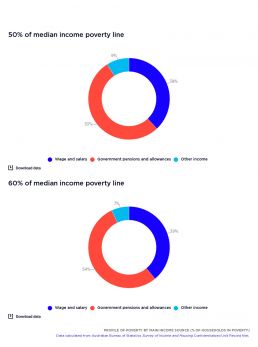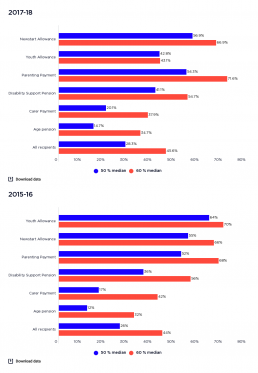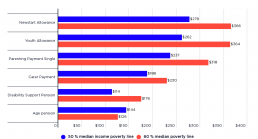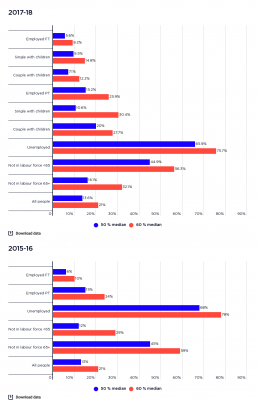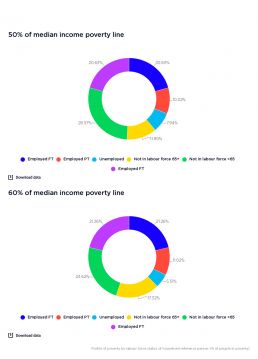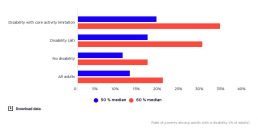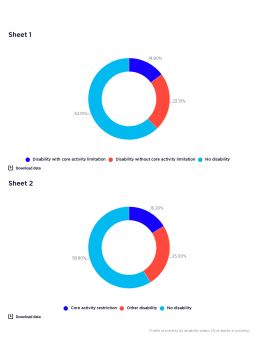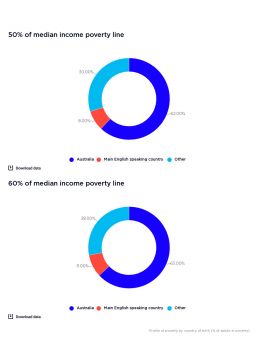Profile of poverty by main income source
This graph shows the profile of households in poverty by their main income source in 2017-18 and 2016-17. It shows that the largest group of households in poverty is that relying on social security. 2017-18 Households relying on social security represent 51% of households in poverty when the 50% and 60% median income poverty lines are used. The share of households living in poverty who are reliant on mainly on wages is significant, reflecting the higher share of wage-earning households overall. This group represents 38% of households in poverty using the 50% median income poverty line and 40% using the 60% of median income poverty line. 2015-16 Households relying on social security represent 53% of households in poverty when the 50% median income poverty line is used and 55% when the 60% of median income poverty line. The share of households living in poverty who are reliant on mainly on wages is significant, reflecting the higher share of wage-earning households overall (38% of all…
Rate of poverty by income support payment
This graph shows the poverty rates for people in households whose reference person receives an income support payment. 2017-18: For all payments, poverty rates average 28% based on the 50% median income poverty line and 46% based on the 60% median income poverty line. The highest poverty rates are for Newstart Allowance recipients (57% based on 50% median income poverty line and 67% based on 60% median income poverty line) and for Parenting Payment (54% based on 50% median income poverty line and 72% based on 60% median income poverty line). Poverty rates in households where the reference person receives Youth Allowance are slightly lower but still substantial (at 43% based on both the 50% and 60% median income poverty lines). 41% of people in households whose reference person receives Disability Support Pension are in poverty (55% using 60% median income poverty line), while 20% of people in households whose reference person receives Carer Payment are below the poverty line (38% when…
Profile of poverty by income support payment
These graphs show the poverty rate of households that receive income support payments. 2017-18 Those in households whose reference person receives the Age Pension are the largest group (28% using the 50% median income poverty line and 40% using the 60% median income poverty line), since the overall Age Pension population is larger than for other payments. This is followed by Newstart Allowance (24% using the 50% median income poverty line and 18% using the 60% median income poverty line), Parenting Payment (23% using the 50% median income poverty line and 18% using the 60% median income poverty line) and Disability Support Pension (17% using the 50% median income poverty line and 14% using the 60% median income poverty line). 2015-16 Those in households whose reference person receives the Age Pension are the largest group (26% using the 50% median income poverty line and 39% using the 60% median income poverty line), since the overall Age Pension population is larger than for other…
Poverty gaps by income support payment
The poverty gap measures the average depth of poverty among households below the poverty line by looking at the difference between their incomes and the poverty line. A large poverty gap shows that the majority of those in poverty are likely to have incomes well below the poverty line. Poverty gaps decline whenever the income of anyone below the poverty line increases, whereas poverty rates only decline when income increases by enough to raise someone from below the poverty line to above it. Thus both poverty rates and poverty gaps are important when looking at poverty. This graph and table show poverty gaps for people in households living below the poverty line when the reference person receives one of the listed income support payments. It is important to read these in conjunction with the poverty rates for that particular group. 2017-18 This graph shows that average poverty gaps, adjusting for household size, are greatest for recipients of Newstart Allowance ($278), Youth…
Rate of poverty by labour force status
This graph compares poverty rates among people according to the labour force status of the household reference person. 2017-18: People who are of working age but who are lacking paid employment face an elevated risk of poverty, at 66% using the 50% of median income poverty line and 76% using the 60% of median income poverty line. Where the reference person is aged under 65 and is not in the labour force, 45% of households are in poverty using the 50% of median income poverty line; and 56% using the 60% of median income poverty line. Many of these households have a reference person with a disability or with caring responsibilities and rely on payments such as Disability Support Pension, Parenting Payment or Carer Payment. Poverty rates are much lower where the household reference person is employed fulltime (6% using the 50% median income poverty line and 9% using the 60% median income poverty line). Since minimum wages are above the poverty lines for a single adult, those in…
Profile of poverty by labour force status
These graphs show the profile of households in poverty by the labour force status of the household reference person. 2017-18 (All people) Although households that rely on paid employment have a much lower rate of poverty, they make up 38% of all people below the 50% median income poverty line, and 42% of all people below the 60% median income poverty line. 2017-18 (Employed fulltime) 2017-18 (Employed parttime) 2015-16 Although households that rely on paid employment have a much lower rate of poverty, they make up 39% of all people below the 50% median income poverty line, and 41% of all people below the 60% median income poverty line. This reflects the fact that three times as many people live in households whose reference person receives income from employment compared with income support payments.
Rate of poverty among adults with disability
This graph looks at the poverty rate of people with disability. People with disability, especially those with more severe incapacities (people who are limited in the core activities they can perform) face an above-average risk of poverty. It is likely that poverty is underestimated amongst people with disability, as the extra costs of a disability are not taken into account when assessing whether people are living below the poverty line, such as the costs of adjustments to home or workplace; care costs; additional transportation costs; and medical and pharmaceutical costs. 2017-18: The rate of poverty among adults with disability is 17.2% using the 50% median income poverty line and 28.4% using the 60% median income poverty line. 2015-16: The rate of poverty among adults with disability is 16.5% using the 50% median income poverty line and 29.4% using the 60% median income poverty line.
Profile of poverty among adults with disability
This graph shows the profile of households in poverty by the disability status of the main reference person. 2017-18 This shows that 37% of people in poverty have disability using the 50% of median income poverty line; and 39% using the 60% median income poverty line. 2015-16 This shows that 38% of people in poverty have disability using the 50% of median income poverty line; and 41% using the 60% median income poverty line. This reflects a combination of the overall rate of disability (18% of the total population in 2015), the higher rate of disability among people aged 65 and over, and the average risk of poverty among people with disability.
Rate of poverty by country of birth
This graph shows the poverty rate of people by their country of birth, divided into those born in Australia, those born in a mainly English-speaking country; and those born elsewhere. 2017-18: The graph shows that people born overseas in a country where English is the main language have a much lower poverty rate – at 9.7% using the 50% median income poverty line and 15.9% using the 60% median income poverty line - compared with those born elsewhere – at 17.5% using the 50% median income poverty line and 27.1% using the 60% median income poverty line. 2015-16: The graph shows that people born overseas in a country where English is the main language have a much lower poverty rate – at 10% using the 50% median income poverty line and 17% using the 60% median income poverty line - compared with those born elsewhere – at 17% using the 50% median income poverty line and 27% using the 60% median income poverty line. This likely reflects the lower employment rates among people from countries…
Profile of poverty by country of birth
This graph shows the profile of adults in poverty by their country of birth. 2017-18 This graph shows that the majority of adults in poverty are people born in Australia (59.3% of 50% median income poverty line and 59.4% of 60% median income poverty line), due to the higher proportion of adults born in Australia. 2015-16 This graph shows that the majority of adults in poverty are people born in Australia (62% of 50% median income poverty line and 63% of 60% median income poverty line), due to the higher proportion of adults born in Australia.
